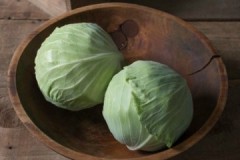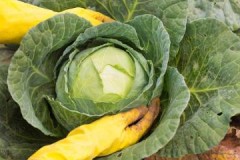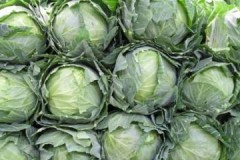Tips and methods on how to properly store cabbage in the cellar until spring
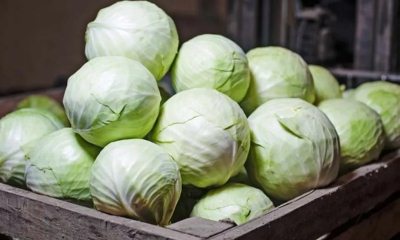 Cabbage is a nutritious vegetable that is used in many dishes.
Cabbage is a nutritious vegetable that is used in many dishes.
You need to know how to properly preserve the harvest harvested in the fall, so that it lays until spring. It is most convenient to use a cellar as a storage.
We will tell you in the article about whether and how to properly store cabbage in the cellar (basement, underground) until spring.
Content
Features of fresh storage for the winter
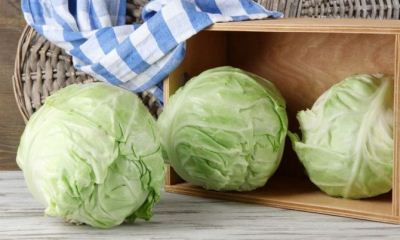 Proper organization of storage conditions will allow you to keep cabbage for months, providing the family with fresh vegetables for the whole winter.
Proper organization of storage conditions will allow you to keep cabbage for months, providing the family with fresh vegetables for the whole winter.
Among the main factors affecting the safety of the crop are two:
- Selection of a suitable variety and selection of healthy heads of cabbage among them.
- Correct cellar arrangement.
Having an equipped basement, it is easy to create suitable conditions for storing vegetables.... For cabbage, these are:
- temperature from -1 ° C to + 2 ° C;
- humidity - from 90 to 98%.
Only under suitable conditions will the cabbage retain its freshness and stay for a long time.
Training
Before placing the cabbage in the cellar, check if all the conditions for this have been created. It is also necessary to inspect and prepare the vegetable itself.
Cooking basement, underground
In order to use the cellar for storage of cabbage, it is necessary to carry out the following work:
- remove the remnants of last year's harvest;
- sweep away dust and debris;
- to carry out protection against rodents;
- treat the basement from mold, using, for example, whitewashing with lime;
- install wooden platforms or shelves.
Preparing the vegetable
Before placing a vegetable in a basement storage, you should choose a storage method that suits your particular case. After that, you need to sort the crop.
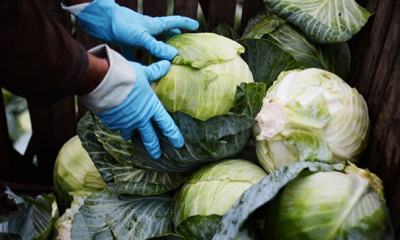 For long-term storage, heads are suitable that meet the following parameters:
For long-term storage, heads are suitable that meet the following parameters:
- the variety is designed for long-term storage;
- the forks are dense, with a rounded or slightly flattened shape;
- heads should be medium in size.
Substandard vegetables, including those that are too small or very large, should be eaten first. This is due to the fact that medium-sized vegetables are best.
It is also necessary to inspect the cabbage heads themselves.... Wrinkled and rotten top leaves are best removed. This must be done because of the high probability of their infestation with spores of pathogenic fungi and pest larvae.
If the heads are wet, then the vegetables should be dried. This can be done both outdoors and indoors.
What's best: ways
There are several ways to store cabbage in the basement. Each of them has its own characteristics. For some, it will be necessary to finalize the arrangement of the cellar (for example, to fix the beams), for others - to stock up on related goods (sand, clay, etc.).
Wooden boxes
Boxes knocked out of boards allow you to compactly save the crop cabbage for a long time. The container itself must be clean and have large enough gaps for good air circulation.
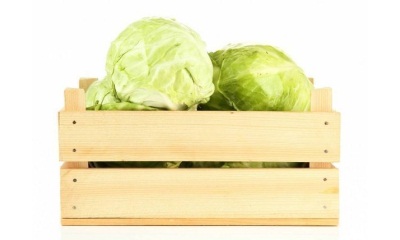 Cabbage is placed in boxes, after cutting off the roots, and removing the upper spoiled leaves. The top boxes are not covered.
Cabbage is placed in boxes, after cutting off the roots, and removing the upper spoiled leaves. The top boxes are not covered.
They are installed on wooden podiums on the floor or on shelves, but always in one row so that air flows to the stored vegetables from all sides. The vegetable is stored in this form all winter.
Boxes should not be pushed tightly against walls or other boxes made of cardboard, plastic or wood, so as not to compromise air permeability.
Tying
This method is the simplest. For its implementation, the following conditions must be met:
- The cabbage must be with an uncut stem, for which the tying is performed.
- In the cellar, a beam or board should be fixed under the ceiling, on which vegetables will be hung for storage.
- A rope is needed with which the cabbage heads will be suspended.
The advantages of this method:
- reliable protection against rodents;
- good ventilation;
- long-term storage - until May.
Disadvantages of this option:
- the need to install beams;
- it is difficult to place a large crop in this way.
In a suspended state, cabbage is stored very well, except that its upper leaves will dry out, but the head itself under them will be clean and strong.
In sand
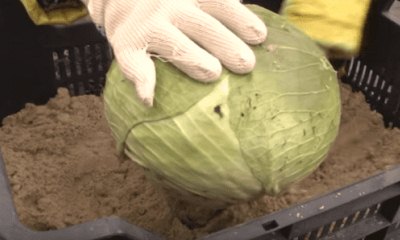 Sprinkling with sand allows you to preserve the natural moisture of the vegetable, and it will be stored until spring. This arrangement can be done on a wooden platform or directly in boxes.
Sprinkling with sand allows you to preserve the natural moisture of the vegetable, and it will be stored until spring. This arrangement can be done on a wooden platform or directly in boxes.
Only dry sand is selected. Step-by-step instruction:
- A layer of sand is filled up.
- Heads unfold.
- More sand is poured so that all the cabbage is completely covered with it.
If you arrange the storage directly on the floor, then the bottom layer of sand should be thick enough not to allow the vegetable to freeze.
In cling film
Film storage is one of the modern methods, which is easy to organize and cheap. Storage with such an organization is long-term, until May-June.
Procedure:
- The head of cabbage is examined, the upper damaged leaves are removed.
- Using cling film in a roll, the cabbage head is carefully and very carefully packed so that 2-3 layers are obtained.
- Heads of cabbage are lowered into the cellar and placed in a prepared place. This can be a platform, shelves, bags, etc.
The advantages of this storage method:
- hygiene;
- good preservation of heads;
- attractive neat appearance.
Disadvantages:
- labor costs for packaging;
- the need to have a stock of film.
How to store cabbage in a cellar in cling film, the video will tell you:
In paper
For storage, you will need plain paper or parchment. Newspapers are an undesirable choice as they contain ink that should not come into contact with food.
With this storage option, the forks are protected from light and moisture, and also have sufficient thermal insulation. But in terms of crop preservation and better insulation, paper packaging loses to cling film.
In clay
 This method is often chosen in cases where there was an experience of unsuccessful storage of the crop, and its defeat by rot:
This method is often chosen in cases where there was an experience of unsuccessful storage of the crop, and its defeat by rot:
- A fairly liquid clay solution is being prepared.
- Each head is dipped in clay.
- Dry.
- Hang by the stem on a board or on a beam under the ceiling of the cellar.
The advantages of this method are even greater than that of simple tying. The disadvantages include the complexity of processing and the need for time-consuming drying. Duration of storage - until spring.
Before eating cabbage stored in clay, it must be thoroughly cleaned and washed.
In bulk (pyramid)
This method refers to ineffective... For its organization, a wooden platform with sides along the perimeter is used. The platform should have gaps for air access and preferably 0.2 m from the floor.
Cabbage is laid out on the resulting site in layers, starting from large, moving to smaller ones. Eating heads of cabbage begins from the upper layers, gradually disassembling the pyramid to the platform.
Another drawback - in case of damage to one of the lower heads of cabbage, you will have to disassemble the entire pyramidto get to the spoiled cabbage.
The storage method is not practical, as it contributes to damage to the cabbage heads and a significant reduction in the shelf life to a maximum of 3-4 months.
How to increase the term?
The average shelf life of cabbage in a cellar is 3-6 months. But this figure is approximate, since storage time largely depends on a large number of factors:
 varieties and type of ripening;
varieties and type of ripening;- the state of the heads of cabbage before laying;
- humidity and temperature in the cellar;
- correct preparation of the cellar room;
- neighborhood with other vegetables and fruits in the same room.
If it is necessary to ensure long-term storage of cabbage, higher than the average, it is recommended to choose hybrids.
They can lie until the next harvest, sometimes even until the end of August. Wherein varieties must be winter, late ripening... Only under such conditions can the shelf life be extended to 8-10 months.
What can and cannot be together?
In the cellar, along with the cabbage, other vegetables that are grown in season are also stored. Is it possible to store heads of cabbage in such conditions?
If it is not possible to divide vegetables into separate rooms, you must adhere to a number of rules.
The "neighbors" for a vegetable are:
- beet;
- carrot;
- potatoes and other vegetables.
Neighborhood rules:
- Diseased vegetables are not stored with healthy vegetables.
- Cabbage should not be mixed with other vegetables.
- It is advisable to maintain a distance between the heads of cabbage.
- Apples and pears should not be placed near cabbage, as they, due to the release of ethylene, stimulate the ripening of vegetables and fruits nearby.
- When stored with cabbage tomatoes, their taste becomes worse.
6 recommendations
Expert advice will help you better cope with the task of storing the cabbage crop. Among them are the following:
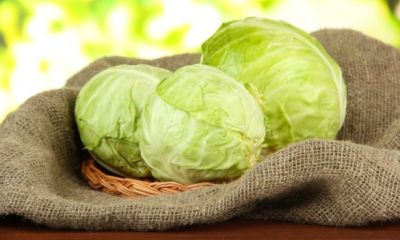 Early maturing varieties are not suitable for long-term storage. They can lie for a maximum of 2-2.5 months.
Early maturing varieties are not suitable for long-term storage. They can lie for a maximum of 2-2.5 months.- Late-ripening varieties are the most preferable for storage, especially hybrid ones.
- Elongated and loose forks hold less well than round and flattened forks that are dense to the touch.
- If cabbage is bought on the market for storage, then it is better to purchase it from mid-September, not earlier.
- It is advisable to collect the vegetable in dry weather, since otherwise you will have to organize the drying of the heads.
- Damaged vegetables cannot be stored with healthy vegetables.
Conclusion
Keeping cabbage in the cellar until spring is a completely solvable task. To do this, you can choose one of the proven methods, taking into account the peculiarities of the organization of the cellar. If all the conditions were met, then the cabbage harvest may well lie until the next harvest.

